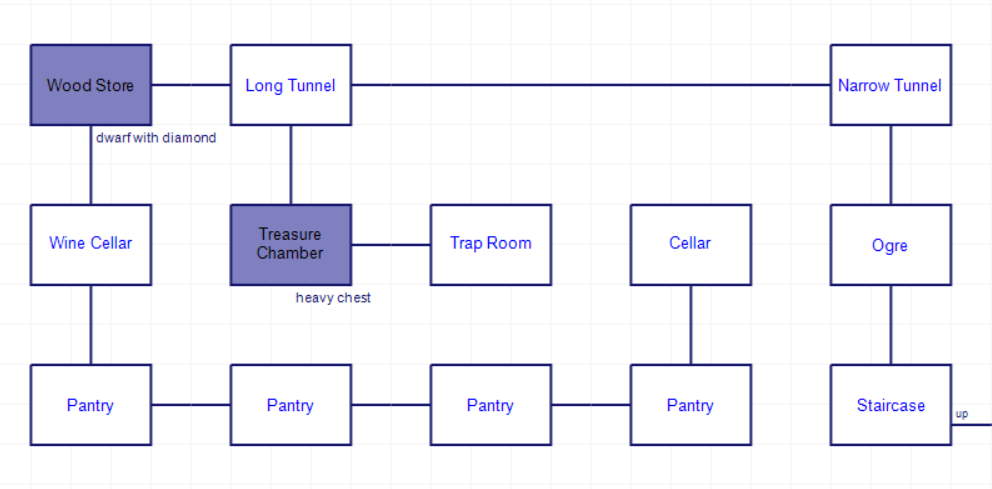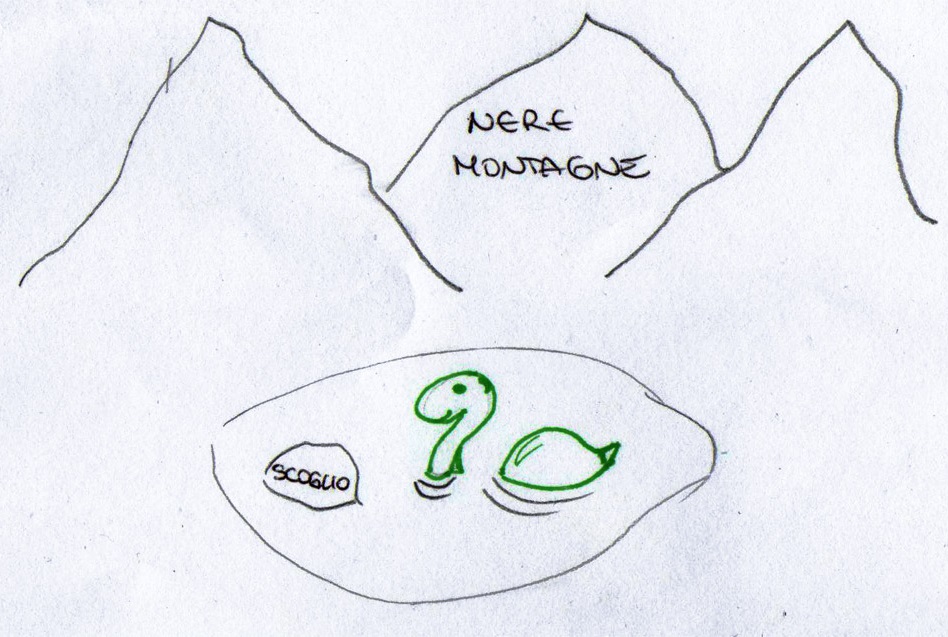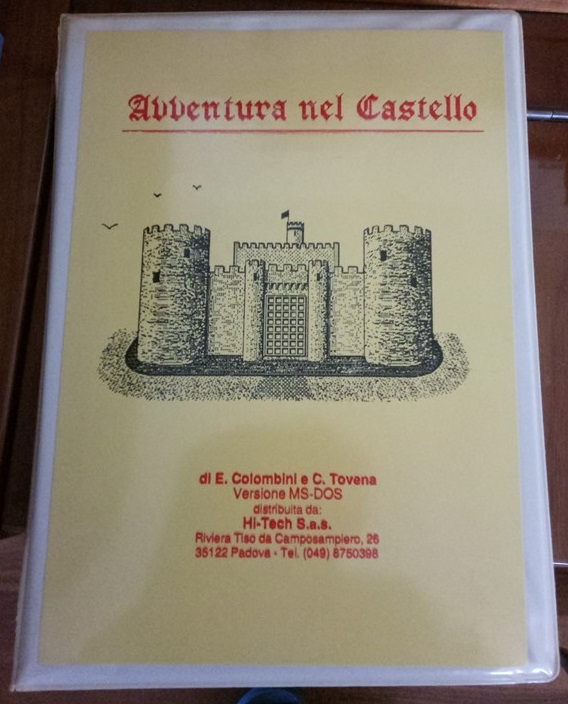I have finished the game. You can read all my entries in order here.
I should preface a little, for the benefit of those who normally don’t read this blog and are here just for this game: this isn’t really a “review blog”, even though you can interpret what I write that way. I’m trying to understand the full span of adventure games, and extract what knowledge I can and place it in historical context. That means some elements of a game may be bad choices, but serve a purpose, or at the very least be “good enough” in a particular setting.
This game was extremely important for Italy, and it had wide enough commercial spread it was some people’s first adventure, or even first computer game of any kind. In this interview with the author from only two weeks ago, in addition to the live comments, there’s this top comment that attests to lasting influence:
Mi sono appassionato alla programmazione proprio grazie ad Avventura nel Castello che giocavo rigorosamente al buio con i miei cugini su un M19. Oggi è il mio lavoro e la mia passione! GRAZIE
I got into my passion for programming specifically because of Avventura nel Castello, which I used to play only in the dark with my cousins using a M19. Today it is both my job and my passion. Thank you!
(M19 refers to the Olivetti M19; Olivetti was one of the big local computer manufacturers; they had started out in typewriters.)
If the game is treated as a place to visit (where you don’t necessarily care about winning) it manages a strong atmosphere; the vast majority of the castle can be reached without solving puzzles, and any new areas are small. So I could see someone playing the game off and on over years, maybe getting to a new place just by sheer persistence, meaning my playthrough is not representative of how people responded at the time.
So while I’m going to be a little hard on this, I’m doing it out of love, but also with the presumption it should be a game played from start to finish without large pauses in the middle.
Last time I was hopeful that perhaps I could turn things around and not rely on poking at hints every other puzzle.
cough
No, sorry. Things got even worse. There was one nifty trick remaining, but the rest of the puzzles were mean in some aspect. (One of the mean parts was also wonderfully audacious in its cruelty, but let’s just see it in context.)
Let’s get a reasonable part out of the way first — relatively speaking, you have to refer to a thing in the room description again:
You’re in a short room crammed with hunting and war trophies. Fixed to the walls are stuffed animal head of all kinds, weapons, shields, even an entire suit of armour that probably belonged to a rival clan chief killed in battle by the Laird himself.
What are you going to do? EXAMINE ARMOR
It is the armour of Sir Crawford, the valiant warrior wizard who, for many years, held MacCallum IV in check with his prowess and his fearsome arts. The armour still maintains a haughty bearing, and even seems to stare at you, leaning on the sword.
You’re in the trophy room.
What are you going to do? TAKE SWORD
Done!
“Reasonable” is relatively speaking. This is still referring to a “second-order” object — that is, it’s an object that gets referred to in the description of an object, and you have the realize you can try to go ahead and take it. I had this in my head because with some different suits of armor (back in the main hall of the castle) I killed myself trying to grab a pike:
You’re in a large hallway, the floor of which bears the signs of the passage of countless generations. A row of armour is lined up along the wall, each holding a long pike.
Towards the centre of the hallway, there appears to have once been a door, now bricked up.What are you going to do? TAKE PIKE
You take the pike and pull it towards you, but the armour doesn’t seem to want to let it go. Should you pull it a wee bit harder ? YES
With a firm tug, you finally manage to get hold of the pike.The armour, unbalanced, wobbles slightly……
and as you step back with the tip of the pike gripped in your hands, the armour falls with all its weight onto the other end of the weapon, piercing you through and through.
This is how it was used in battle!
So I was at least somewhat prepared to grab the sword. The sword is described as having a “spell” on its blade. You can try to read the spell and the game mysteriously asks if you mean to read it out loud.
What are you going to do? READ SPELL
Should you say it out loud? YES
Nothing is happening.
Back down past the ogre that the cat ate last time there are two things: a dwarf holding a diamond, and a chest. (Both locations are marked on the map below.)

The chest is where the spell goes, and yes, it’s very arbitrary:
What are you going to do? OPEN CHEST
The ghost of Malcolm’s faithful squire, Edgar MacDouglas, rises to defend the treasure of his ancient Laird from the foreign defiler.
You’re in the treasure chamber.
I can see a heavy chest.
I can see a ghost.
Yes, if you go back and look at the sword, and specifically the armor, it seems to be someone who defined the Laird family of the castle, so it makes some sense after the fact that the spell on the sword would help oppose a spirit who identifies with the Lairds. It’s still very after-the-fact reasoning, and made worse by an extra obstacle: when you try to read the spell out loud voice is cracked.
Your throat is dry with fear…
You can’t speak…
The ghost takes advantage of this to attack you.
I very briefly mentioned last time some honey milk I fed to a cat; the cat is takeable without giving over the milk. I had unknowingly soft-locked the game. The milk is supposed to be saved so you can use it on yourself, although you have only one turn, the one immediately before stating the spell.
What are you going to do? DRINK MILK
Lip-lickingly delicious!
What are you going to do? READ SPELL
Should you say it out loud? YES
With a long, desperate wail, the ghost returns to the nothingness from which it came.
The honey is sort of a hint about throat control, but this puzzle was, at the very least, kind of mean. The chest, ghost-free, yields up a hunting horn.
It is decorated with hunting scenes that wrap around in a spiral from its mouth. Galloping riders are seen to chase their prey, while large birds circle overhead.
The one after is as well:
You are in the wood store, where dry branches and logs of various sizes are stacked in perfect order.
I can see a wee dwarf with a big diamond.What are you going to do? EXAMINE DWARF
He’s quite small.
What are you going to do? EXAMINE DIAMOND
The more you observe the wonderful gemstone, the more you become overwhelmed by an unbridled desire to possess it.
You do need the diamond, but can’t steal it away or defeat the dwarf in combat or anything like that. You’re just supposed to GREET (or in Italian, SALUTA) it:
The dwarf is so happy to finally meet such a courteous person that he simply gives you the diamond.
This is one of those puzzles if you run 20 people through, someone is bound to get it just by trying naturally, but it is hard to work out what the natural thought process for a solution might otherwise be.
The game then rather cheekily warns you to be careful with the newly-acquired diamond:
It’s magnificent: the light reflected and refracted by its a thousand perfect facets creates an infinite play of colour. You are fascinated by it, and would observe it for hours and hours. I think it’s of inestimable value, and you should treat it with utmost care.
However, remember: this is not a treasure hunt! We don’t care about treasures. We care about getting out of the castle. Somehow (…magic?…) the bludgeon from down the basement (the one that required using a bone to get) is able to smash the diamond, and we can then get a key.
On the first blow of the bludgeon, the diamond shatters into a thousand pieces.
Conceptually, I see the point here: the narrator has been a little bit off-kilter since the very first puzzle, so the very strong suggestion to treat the diamond with utmost care can be thought of as giving instructions to do the opposite. That doesn’t stop the puzzle from being amazingly cruel.
The key and the horn are the two items needed to escape. We need to head back to the maze, the one I mentioned last time led to nowhere when I mapped it out, but we got an explicit hint I hadn’t applied yet:
‘Only by the good use of sense will you find your way out from the labyrinth’
This is a puzzle we’ve seen before but somehow the phrasing threw me off here. It works both in Italian and in English, and by making that statement, I’ve given the hint that wordplay is involved.
‘Only by the good use of sense will you find your way out from the labyrinth’
We’re not using “our senses” (as I first read it) we are using the word “sense”, giving the sequence south, east, north, south, east. (Without having read the hint first, this just returns the player to the entrance.)
In Italian, the word is SENNO, which might seem like it breaks, but the Italian word for “west” is “ouest”! So S, E, N, N, O is the solution in that version of the game.
What are you going to do? E
You’re in the large secret room, under the castle tower. A current of icy air
hisses through invisible cracks.
I can see a lever.
I can see a stopped old pendulum clock.
I imagine for people who didn’t ping at the walkthrough for items this puzzle was completely stumped; here, I was just mostly stumped. The key is not the kind of key to unlock things, but the kind of key to wind things. You can WIND the clock, causing it to start ticking. It was close to but not right at midnight, and when it reaches midnight:
A stone block shifts, revealing a spiral staircase.
This leads you to the roof, and once again, you have to make arbitrary use of a magic item.
You’re at the top of the tower, where your gaze sweeps above the fog covering the peatland, and towards the distant mountains.
I can see a flag in tatters.What are you going to do? TAKE FLAG
The old flagpole evades your grip… and suddenly gives way, making you lose your balance. You fall down onto the parade ground.
(Or you can try fiddling with the flag, but that’s a red herring, it kills you.)
You have to use the horn. Now, we hit the one part where the English version is much harder than the Italian version. You would think to BLOW HORN, but no, that verb is not understood. I was completely baffled and checked the required verb in Italian, which is SUONA, which I’d still translate (in the context of using the word on a horn in English) to “BLOW”. But they (Adam Bishop, the translator) translated it to SOUND, like SOUND HORN. This is the first time I’ve had that as a required verb in an adventure game, and it may be the only time I ever see it. Yes, it technically is grammatical, but more along the lines of terminology from a prior century.
What are you going to do? SOUND HORN
The ancient horn sounds across the moor, echoing off the distant mountains. A black dot rises from the mountains and grows larger as it approaches. Quickly it reaches the tower: it’s a large golden eagle that lurches towards you with its claws extended.
What are you going to do?
This is a fake-out; you can’t type anything before being interrupted. Oh also, you needed the parachute here, otherwise you die; theoretically an easy puzzle to resolve after dying once, but someone might have dumped their parachute back in the first room where it would be inaccessible and have to restart the whole game.
You have no chance:
The eagle grabs you, quickly lifting you up to a great height.The eagle flies for a long time while the landscape races beneath you… … … … … … … … … … … … . .. … … … … … … … … … … … … … … … … …Loch Ness appears in the distance… … … … … … … … … … … … … . .. … … … … … … … … … … … … … … … … …Suddenly, the eagle lets go of you.
You gently descend in the dying daylight. Below you are the dark waters of Loch Ness. The wind pushes you towards the centre of the lake. By chance, you land on a small outcrop of rock.
While you fold away your parachute, you look around:You’re alone and abandoned on a black rock peaking above the icy waters. Let me correct myself, you are not alone: the Loch Ness Monster (Nessie among friends) is there to keep you company.
The Loch Ness Monster is not trying to be your friend.

Depiction of the final area via Oldgamesitalia.
Arbitrary magic is your friend again. This is solvable in a “well, there’s nothing else I can do” sense but not in a logical sense.
The ancient horn sounds across the moor, echoing off the distant mountains. A black dot rises from the mountains and grows larger as it approaches. Quickly it reaches the rock: it’s a helicopter from the Royal Archaeological Service, which throws you down a rescue ladder. You climb the ladder as the monster’s jaws snap shut inches below you.
You are informed the horn is Malcolm the Fourth’s thought to be worth “a million pounds or more”, but upon landing we get charged with crimes.

At least the game compensates you with what I think is the best title for winning a game I’ve ever heard.
Anyhow, console yourself: you have finally earned the 1000 points that give you the right to boast the coveted title of:
THE DEVIL’S LIEUTENANT!!!
Look: I loved original Adventure as a child, but I never came close to beating it. I was able to explore most of it — even the part past the plant, which was one of the easier puzzles — and while I didn’t solve the golden eggs puzzle until I was a grown adult (so had to sacrifice treasure at the troll) I still had a grand time and have many core memories exploring the dense caverns. Similarly, while I’m sure someone will chime in they somehow solved this game without help, I’m guessing a lot of the people this game influenced treated Castle Adventure as a destination to explore, with the fact there were unplumbed secrets making something of a bonus.
And certainly: the text has a great sense of attitude, both in the Italian original and the relatively literal translation. The deaths were amusing and while the softlocks were terrible they weren’t overwhelming either; you also don’t have to bother with a light timer like so many Adventure clones felt obligated to include.
So while I only recommend this for the historically curious (English version here) I’m glad that it exists.

As an Italian, I am glad to see this milestone game appear in your blog. A pity you seem not to have had much fun from it, and I wonder how much went “lost in translation”. For context, I played the 1987 DOS version a couple of years ago and found it very enjoyable, and I was able to solve it in about a week, using just one hint. But, to be fair, other Italian retrogaming reviewers were less kind, so I guess it was a case where the setting and tone worked for me and allowed me to forgive the many shortcomings of the implementation.
Is there anything in the Italian that makes greeting the dwarf easier to figure out? That was the one that I was most baffled by.
Oh, for that one I was getting desperate. At the end, trying random verbs, I happened to type “DI” (“say”). To which I was prompted what I wanted to say. An answer of “CIAO” (“hi”) had the dwarf comment I was somewhat too informal, but he appreciated the saluation and gave me the diamond.
So, while GREET is quite hard to guess, I think SAY is a verb that has some chance to be found.